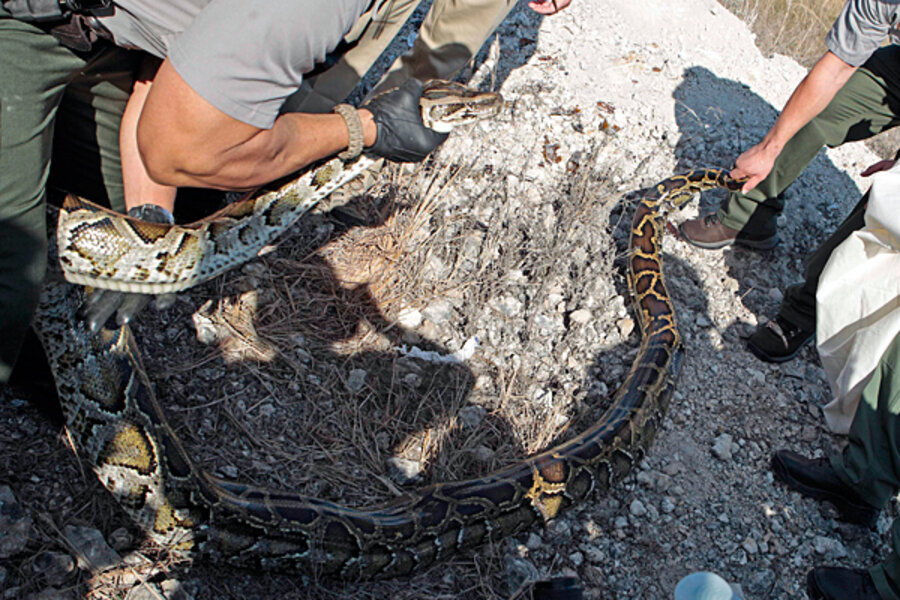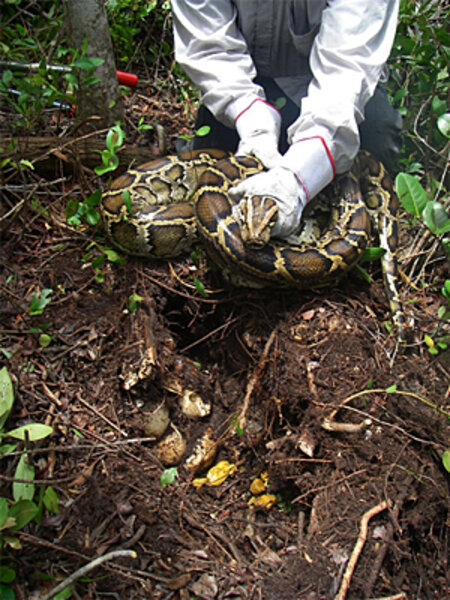Snakes in the grass: Is the Burmese Python wiping out Everglades mammals?
Loading...
| Ft. Lauderdale, Fla.
Scientists believe they may be recording the first significant impact of the explosive spread of Burmese Pythons in South Florida’s Everglades National Park.
A recent study suggests that the proliferation of the non-native pythons is causing severe declines in the populations of raccoons, opossums and other common mammals in the park. It may also eventually decimate endangered species of both mammals and birds.
“Before 2000, mammals were encountered frequently during nocturnal road surveys,” says the report, published in Proceedings of the National Academy of Sciences. “In contrast, road surveys … from 2003-2011 documented a 99.3 percent decrease in the frequency of raccoon observations, decreases of 98.9 percent and 87.5 percent for opossum and bobcat observations.”
Rabbits and raccoons were once described as the most common mammals in the Everglades. The researches failed to detect a single rabbit. White-tailed deer sightings are down 94.1 percent.
The problem isn’t just a growing number of hungry snakes. Certain mammals native to Florida have no recent experience with large predatory snakes.
“For at least 16 million years, there have been no snakes in Florida large enough to prey on medium-sized mammals,” the report says.
That changed in the 1990s, when a significant number of Burmese Python pets escaped and/or were released in South Florida. By 2000, researches had identified a breeding population in the southern section of the park east of Flamingo.
In the years since, the snakes have continued to breed, grow, eat, and spread. They can grow to 16 feet, large enough to eat a deer and even battle the other top predator in the Everglades, the alligator. The pythons are excellent swimmers and appear to have used man-made canals to cover significant distances with little risk of detection or harm from man.
The study includes a map that shows pythons are extending their range north of Marco Island on Florida’s west coast, north of Interstate 75 in the central Everglades, east to the edge of the national park, and southeast to Key Largo.
“In areas where pythons have been established longest (southern Everglades National Park), mammal populations appear to have been reduced severely; in peripheral areas where pythons have been documented only recently, several species of mammals appear to occur at lower densities than at sites where pythons have not been documented,” the study says.
The snakes could jeopardize the struggling population of endangered Florida panthers, not only by reducing the amount of prey generally available, but by making panthers a prey item.
One potential upside to the python infestation, is that by reducing the raccoon population it may bolster the ability of turtles, crocodiles, and birds to breed. Raccoons are known to raid nests for eggs. Fewer raccoons means more undisturbed nests and potentially more juvenile turtles, crocodiles, and birds.
“Whether mammal populations will remain suppressed or will rebound remains to be seen,” the study says. “The magnitude of these declines underscores the apparent incredible density of pythons in Everglades National Park and justifies intensive investigation into how the addition of novel apex predators affects overall ecosystem processes.”
The study was conducted by researchers from Davidson College, Virginia Tech, the University of Florida, Auburn University, the State Museum of Pennsylvania, Denison University, the US Geological Survey, and Everglades National Park.








